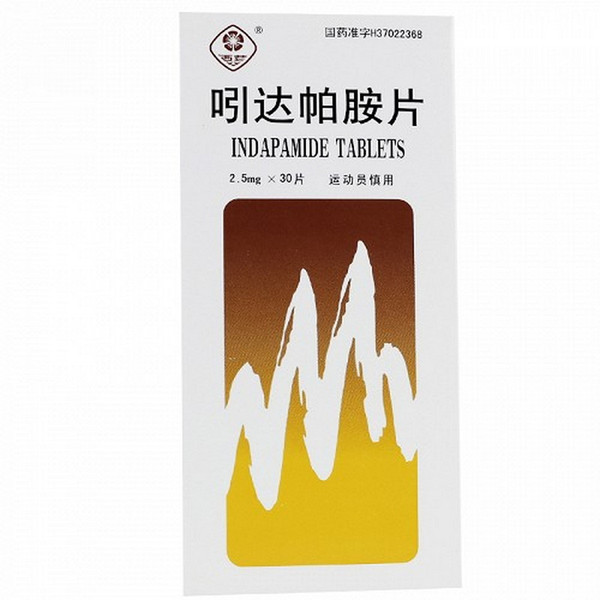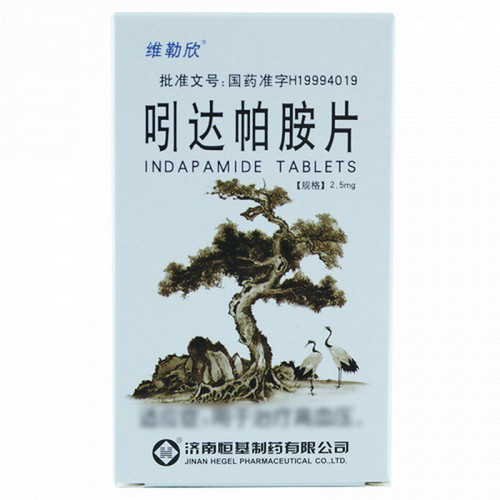Product Overview
[Drug name]
Generic name: Indapamide tablets
Trade name: Xiyuan Indapamide tablets 2.5mg*30 tablets
Pinyin full code: YinDaPaAnPian
[Main ingredients]
The main ingredient of this product is indapamide.
[Properties]
This product is a sugar-coated tablet. After removing the sugar coating, it appears white.
[Indications/main functions]
Used to treat hypertension.
[Specifications]
2.5mg*30 tablets (Xiyuan)
[Usage and dosage]
Adults usually take it orally, 1 tablet at a time, once a day.
[Adverse reactions]
Relatively mild and short-lived, dose-related. 1. Less common are: diarrhea, headache, loss of appetite, insomnia, nausea, orthostatic hypotension, 2. Rare are: allergic reactions such as rash and itching; hyponatremia, hypokalemia, hypogastric alkalosis.
[Contraindications]
Allergic to sulfonamides, severe renal insufficiency, hepatic encephalopathy or severe hepatic insufficiency, hypokalemia.
[Drug Interactions]
1. The diuretic and natriuretic effects of this product are weakened when used with adrenocortical hormones; 2. This product is prone to arrhythmia due to low blood potassium when used with amiodarone; 3. The anticoagulant effect of this product is weakened when used with oral anticoagulants; 4.The natriuretic effect of this product is weakened when used with non-steroidal anti-inflammatory analgesics; 5. The diuretic effect of this product is enhanced when used with dopamine; 6. The antihypertensive effect of this product is enhanced when used with other types of antihypertensive drugs; 7. The antihypertensive effect of this product is weakened when used with sympathomimetics; 8. When used in combination with lithium, this product can increase blood lithium concentration and show signs of overdose; 9. When used in combination with large doses of salicylates, dehydrated patients may develop acute renal failure; 10. Lactic acidosis is prone to occur when used in combination with metformin.
[Precautions]
1. To reduce the possibility of electrolyte imbalance, a smaller effective dose should be used, and blood potassium, sodium and uric acid should be monitored regularly, and attention should be paid to maintaining water and electrolyte balance, and timely potassium supplementation. 2. When used as a diuretic, it is best to give the drug once a morning to avoid getting up at night to urinate. 3. Anuria or severe renal insufficiency can induce azotemia. 4. Diabetes can make glucose tolerance worse. 5. Gout or hyperuricemia, at this time, blood uric acid can be further increased. 6. Liver dysfunction, diuresis can induce hepatic coma. 7. After sympathectomy, the antihypertensive effect will be enhanced at this time. 8. When this product is used and surgery is required, it is not necessary to stop using this product, but the anesthesiologist must be informed.
[Drug use in children]
It is not clear yet.
[Drug use in elderly patients]
The elderly are more sensitive to antihypertensive effects and electrolyte changes, and often have changes in renal function. Caution should be taken when using this product.
[Overdose]
No toxic effects were found when the dosage reached 40mg, which is 16 times the therapeutic dose. The primary symptoms of acute poisoning are water and electrolyte disorders (hypotension and hypokalemia). Clinical symptoms may include nausea, vomiting, hypotension, cramps, drowsiness, unconsciousness, polyuria or oliguria, or even anuria (caused by hypovolemia). The first measure to be taken is to quickly eliminate the ingested drugs, which can be done by gastric lavage and/or taking activated carbon, and then correct the water and electrolyte disorders in a specialist center until they are normal.
[Pharmacology and Toxicology]
It is a sulfonamide diuretic that works by inhibiting the reabsorption of water and electrolytes in the dilution segment of the distal renal tubular cortex. The antihypertensive effect is unclear, and its diuretic effect cannot explain the antihypertensive effect, because the dose of antihypertensive effect is much smaller than the dose of diuretic effect. Possible mechanisms include the following aspects: regulating calcium influx in vascular smooth muscle cells; stimulating the synthesis of prostaglandins PGE2 and prostaglandins PGI2; reducing the hypersensitivity of blood vessels to vasopressor amines, thereby inhibiting vasoconstriction. This product has little or no effect on cardiac output, heart rate and heart rhythm when lowering blood pressure. Long-term use of this product rarely affects glomerular filtration rate or renal blood flow. This drug does not affect the metabolism of blood lipids and carbohydrates.







